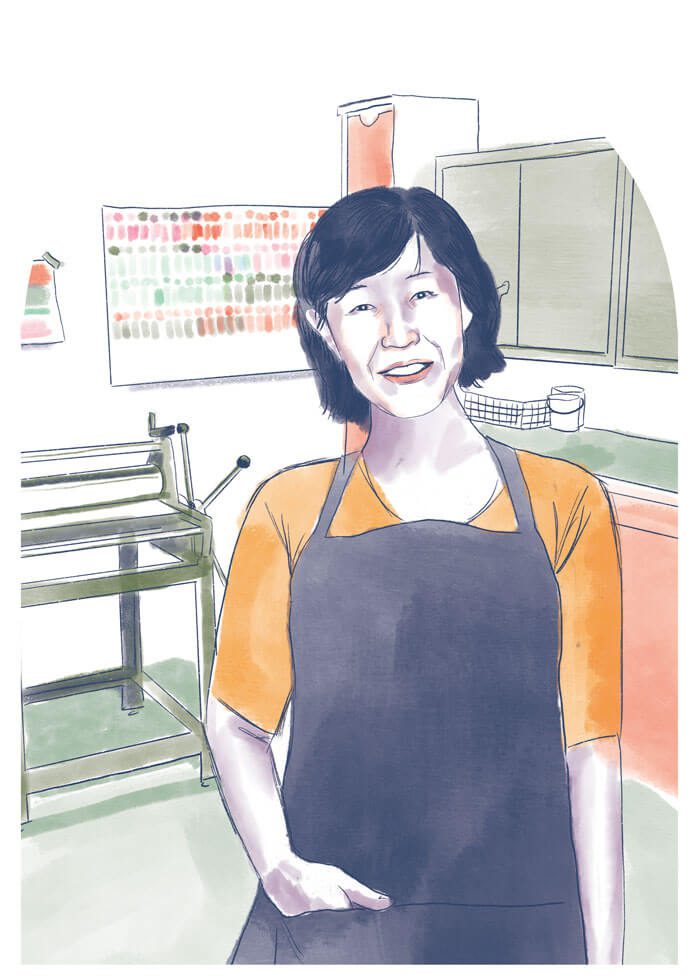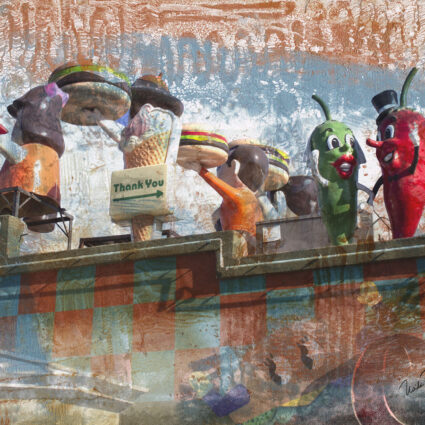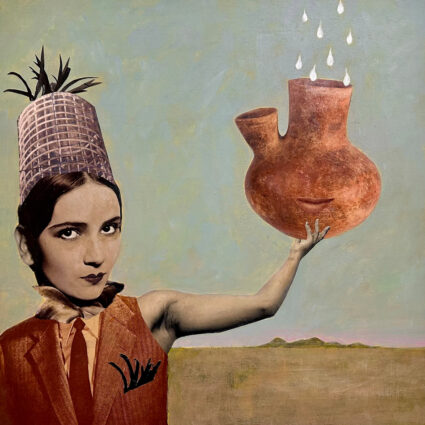
Name: Yoshiko Shimano
Born: 1963, Tokyo, Japan
Lives: Albuquerque, New Mexico
Role: Printmaker
Yoshiko Shimano greeted me with a warm, broad smile when we met in the art building at the University of New Mexico. There, she is a beloved educator and printmaker. Her pieces are large installations that incorporate many modes of printmaking and often have humanistic subject matter. Shimano grew up in Tokyo and attended public schools, where she began practicing various forms of printmaking in the first grade. “Printing is a part of the culture in Japan. In the public schools, children begin basic printmaking in the first grade, and by the time they are in the third grade, they have their own set of carving tools to make woodblock prints,” she described. Shimano brought her deeply ingrained knowledge of printmaking with her to the U.S. when she attended the California College of Arts and Crafts in Oakland, California.
Shimano honed her skills and eventually went on to graduate studies while working in a professional print shop. It was there that she learned she was not a “printer” but wanted to use printmaking in her art. “I used to make editions for other artists, and it became clear to me that they were using printing as a kind of secondary market, to reproduce and sell more work. I wanted to make something that only I could print,” she said. She began to combine printing processes such as lithography, photography, and intaglio to create one-of-a-kind pieces that defy what most people think of as traditional printmaking. Many of her pieces are time-intensive, which further reflects recurring themes of meditation and prayer in her work.
“In the end, I think people will still believe that it is necessary to use our hands to make things. You cannot totally rely on AI or computers to create. I believe that only human beings can create, which is why education is so important.”
One of the most memorable stories Yoshiko told me during our interview was about an old Japanese tradition in which a woman would sew a belt with one thousand stitches for her husband before he went off to war. It was believed that the stitches were prayers and would protect the man during battle. “I don’t know if the belt did anything to keep the man safe, but I am sure that it kept the woman’s worries at ease while she was making it. I am very interested in these stories of people using their hands as part of prayer, especially women,” she said. Shimano has multiple projects dedicated to her interest in handiwork and meditation. One Thousand Prayers is a series of monumental size and effort that reflects the artist’s commitment to the meditative—and potentially healing—benefit of making. Prayers in Daycare, on the other hand, is a series of representational prints that depicts potholders her daughter created while waiting to be picked up.
Shimano is worried that the culture of making is diminishing as technology becomes more omnipresent. She has noticed the decline in drawing skills as well as even everyday life skills among incoming students in the classes she teaches. We spoke of this phenomenon and the potential consequences which range from physical abilities in art-making to the power of having personal experiences that are unmediated by any device. “It seems like everything they know, they Google search and can find answers right away—but that is not necessarily becoming their own experience… I want them to gain confidence and experience the world around them,” she said emphatically. We agreed that there is something innately important about the process of discovery and learning through trial and error, which not only makes a good artist but a wise person. She aims to expose her students to as much as she can while they are in her classroom, from scrubbing out sinks to visiting museums in San Francisco.
My final question to Shimano was what she sees for the future of art-making. “In the end, I think people will still believe that it is necessary to use our hands to make things. You cannot totally rely on AI or computers to create. I believe that only human beings can create, which is why education is so important.” Shimano’s prints are a testament to the touch of the human hand and the power of creativity. They could even be considered shrines to humanity and the very human hopes and feelings that have driven their creation.



